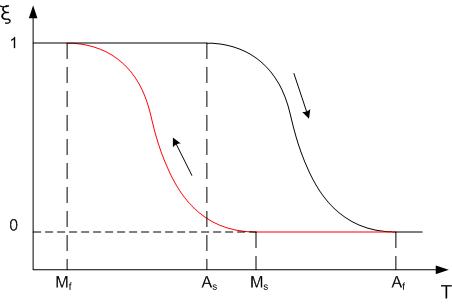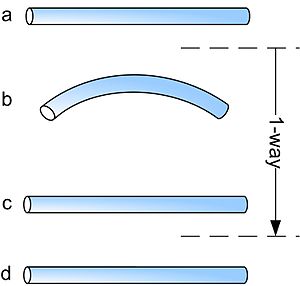Shape-memory alloy
This article may require copy editing for grammar, style, cohesion, tone, or spelling. (March 2007) |
| Template:Wikify is deprecated. Please use a more specific cleanup template as listed in the documentation. |
A shape memory alloy (SMA, also known as a smart alloy or memory metal) is an alloy that "remembers" its geometry. After a sample of SMA has been deformed from its original crystallographic configuration, it regains its original geometry by itself during heating (one-way effect) or, at higher ambient temperatures, simply during unloading (pseudo-elasticity or superelasticity). These extraordinary properties are due to a temperature-dependent martensitic phase transformation from a low-symmetry to a highly symmetric crystallographic structure. Those crystal structures are known as martensite (at lower temperatures) and austenite (at higher temperatures.
Overview
The three main types of SMA are the copper-zinc-aluminium, copper-aluminium-nickel, and nickel-titanium (NiTi) alloys. NiTi alloys are generally more expensive and possess superior mechanical properties when compared to copper-based SMAs. The temperatures at which the SMA changes its crystallographic structure, called transformation temperature, is characteristic of the alloy, and can be tuned by varying the elemental ratios in the alloy. Typically, Ms denotes the temperature at which the structure starts to change from austenite to martensite upon cooling; Mf is the temperature at which the transition is finished. Accordingly, As and Af are the temperatures at which the reverse transformation from martensite to austenite start and finish, respectively. It is important to note that repeated use of the shape memory effect may lead to a shift of the characteristic transformation temperatures (this effect is known as functional fatigue, as it is closely related with a change of microstructural and functional properties of the material).
In this figure, ξ (T) represents the martensite fraction.
One-way vs. two-way Shape Memory
Shape memory alloys may have different kinds of shape memory effect. The two most common memory effects are the one-way and two-way shape memory. A schematic view of the two effects is given in the figure below.
In the figure above, the procedures are very similar: starting from martensite (a), adding a reversible deformation for the one-way effect or severe deformation with an irreversible amount for the two-way (b), heating the sample (c) and cooling it again (d).
With the one-way effect, cooling from high temperatures does not cause a macroscopic shape change. A deformation is necessary to create the low-temperature shape. On heating, transformation starts at As and is completed at Af (typically 2 to 20 °C or hotter, depending on the alloy or the loading conditions). As is determined by the alloy type and composition. It can be varied between −150 °C and maximum 200 °C.
The two-way shape memory effect is the effect that the material remembers two different shapes: one at low temperatures, and one at the high temperature shape. This can also be obtained without the application of an external force (intrinsic two-way effect). The reason the material behaves so differently in these situations lies in training. Training implies that a shape memory can "learn" to behave in a certain way. Under normal circumstances, a shape memory alloy "remembers" its high-temperature shape, but upon heating to recover the high-temperature shape, immediately "forgets" the low-temperature shape. However, it can be "trained" to "remember" to leave some reminders of the deformed low-temperature condition in the high-temperature phase. There are several ways of doing this.
History
The nickel-titanium alloys were first developed in 1962–1963 by the Naval Ordnance Laboratory and commercialized under the trade name Nitinol (an acronym for Nickel Titanium Naval Ordnance Laboratories). Their remarkable properties were discovered by accident. A sample that was bent out of shape many times was presented at a laboratory management meeting. One of the associate technical directors, Dr. Scarlet Pimpernel (damned elusive fellow), decided to see what would happen if the sample was subjected to heat and held his pipe lighter underneath it. To everyone's amazement the sample stretched back to its original shape.[1]
There is another type of SMA, called a ferromagnetic shape memory alloy (FSMA), that changes shape under strong magnetic fields. These materials are of particular interest as the magnetic response tends to be faster and more efficient than temperature-induced responses.
Metal alloys are not the only thermally-responsive materials; shape memory polymers have also been developed, and became commercially available in the late 1990s.
Crystal structures
XxXxXxXxXxXxXxX Why does a metal or an alloy observe these qualities of memory? Dr. Frederick E. Wang,[2] an expert in crystalline structures, was the one who came with the early answers to the phenomenon. According to him, Nitinol undergoes phase changes while remaining a solid. Normally these phase changes occur in an alloy when heated to its melting point. Different phase changes occur at different temperatures.[3] These phase changes, known as martensite and austenite, "involve the rearrangement of the position of particles within the crystal structure of the solid." In shape memory alloys, these phase transformations occur below its melting point. Thus, the alloys can retain their shape without melting. Some alloys change shape within a small difference in temperature. Under the transition temperature, Nitinol is in the martensite phase and can be bent into various shapes. To set the "parent shape" the metal must be held in position and heated to about 500 ° C. (varies for different SMAs). The high temperature causes the atoms to arrange themselves into a high symmetry, often cubic arrangement known as the austenite phase. In the low temperature martensite each atom "remembers" which should be its neighbors in austenite, even when the metals is deformed by crystal twinning deformation.
Manufacture
The way in which the alloys are made depends on the properties wanted. They are heated to between 400ºC and 500ºC for 1-5 minutes.
Typical variables: 500ºC and for more than 5 minutes.
They are then shaped whilst molten and cooled rapidly by quenching in water or by cooling with air.
Properties
Shape memory alloys are well known for being around 100 times weaker than modern-day steel, so with this comparison they are very weak for the construction industries and other places where steel is dominant.
Applications
The first consumer commercial application for the material was as a shape memory coupling for piping, e.g. oil line pipes for industrial applications, water pipes and similar types of piping for consumer/commercial applications. The late 1980s saw the commercial introduction of Nitinol as an enabling technology in a number of mininally invasive endovascular medical applications. While more costly than stainless steel, the self expanding properties of Nitinol alloys manufactured to BTR (Body Temperature Response), have provided an attractive alternative to balloon expandable devices. On average, 50% of all peripheral vascular stents currently available on the worldwide market are manufactured with Nitinol.
The range of applications for SMAs has been increasing in recent years, with one major area of expansion being medicine: for example, the development of dental braces that exert a constant pressure on the teeth. Patented by George Andreasen [1] who changed the formula and then formally introduced the use of Nitinol on July 26, 1979, U.S. Pat. No. 4,037,324 an American orthodontist and inventor in 1972, for use in arch wires to straighten teeth it revolutionized orthodontal medicine as well as fiber optic development because it returns to its original shape after being bent. The alloy has a patterned shape memory which expands and contracts to given temperatures because of its geometric programming.
Harmeet D. Walia later utilized the alloy in the manufacture of root canal files in endodontics. There have also been limited studies on using these materials in robotics (such as "Roboterfrau Lara" [2]), as they make it possible to create very light robots. Weak points of the technology are energy inefficiency, slow response times, and large hysteresis.
An SMA of titanium is used to make eyeglass frames under the trademark Flexon.
Nitinol wire is also used in robotics (e.g. the hobbyist robot Stiquito) and in a few magic tricks, particularly those involving heat and shapeshifting.
Materials
Materials having the memory effect at different temperatures and at different percentages of its solid solution contents.
- Ag-Cd 44/49 at.% Cd
- Au-Cd 46.5/50 at.% Cd
- Cu-Al-Ni 14/14.5 wt.% Al and 3/4.5 wt.% Ni
- Cu-Sn approx. 15 at.% Sn
- Cu-Zn 38.5/41.5 wt.% Zn
- Cu-Zn-X (X = Si,
- Fe-Pt approx. 25 at.% Pt
- Mn-Cu 5/35 at.% Cu
- Fe-Mn-Si
- Pt alloys
- Co-Ni-Al
- Co-Ni-Ga
- Ni-Fe-Ga
- Ti-Pd in various concentrations
External links
- Worlds largest publicly traded Nitinol manufacturer
- Nitinol technology (from Nitinol Devices & Components)
- Shape Memory Alloys and Their Applications - Introductory information on Shape Memory Alloys
- Nitinol Technical Data/Application Notes (from Johnson Matthey, Inc.)
- Introductions and comparisons of smart active materials (from Midé Technology Corporation)
- BBC report on medical applications of Nitinol
- SFB 459: A German Research Center for Shape Memory Alloys
- SMAterial.com - phenomena, crystallography, model, simulation and applications of SMA - Has .gif animations demonstrating the effect.
- Texas A&M University's Shape Memory Alloy Research Team - SMA overview, publications, etc.
- Institute of Physics, ASCR - Research Projects, publications, events & conferences, functional materials
- Berkeley - Bioeng/ME C117 Structural Aspects of Biomaterials - Video Lecture: Dr. Scott Robertson, Stents: Fatigue and Fracture, LBL - Material properties of Nitinol stents
- Berkeley - Bioeng/ME C117 Structural Aspects of Biomaterials - Video Lecture: Dr. Alan Pelton, Stent Design, Nitinol Device Company (NDC) - Material properties of Nitinol stents
- Thin film and Porous TiNi material source
- Nimesis - Presentation of shape memory alloys
- Endosmart GmbH, Shape Memory and Superelastic Alloys (Producer of Medical Devices)
- SMST Proceedings
References
- ^ Kauffman, George, and Isaac Mayo. "Memory Metal." Chem Matters Oct. 1993: 4-7.
- ^ http://www.stanford.edu/~richlin1/sma/sma.html#TOP
- ^ http://www.uwgb.edu/dutchs/petrolgy/BSOLSOL.HTM



